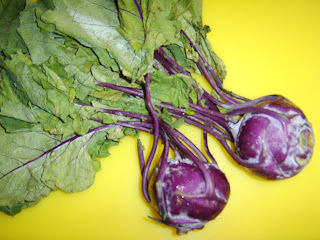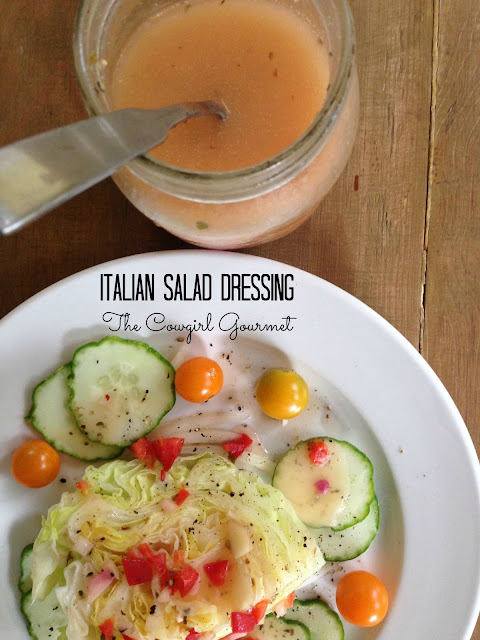Kohlrabi is King
Vegetables are our friends.
Well, at least they're my friends. And I wish more people would branch out and try new, almost obscure veggies. There's so much more out there to enjoy other than boring steamed broccoli, green beans and the ubiquitous asparagus. For the record, corn is not a vegetable. Sorry, guys. It's a grain.
I recently posted some tips on roasting vegetables, which I think is a great place to start when introducing new veggies into your repertoire. Roasting adds substantial flavor through the caramelization and makes most vegetables taste completely different than when they are steamed, blanched, boiled or even eaten raw.
Take beets, for example, I don't think I could choke down a boiled beet, but a roasted one is utterly divine.
I mean, really, it's the year 2010, who boils vegetables? Saute, braise, steam, roast, absolutely. But boil? No, thanks...
Except for kohlrabi.
What is kohlrabi, you ask?
Kohlrabi is a German turnip which explains why my German grandmother who hailed from New Braunfels made them all the time. I loved them when I was a kid and I love them now. And I take pride in turning people on to kohlrabi. (The photo above is of a purple kohlrabi and there is also a greenish-white kohlrabi, which is more mainstream.)
It has the texture of a turnip, the mildness of a potato and the sweetness of a zucchini. Kohlrabi is best when boiled in water and a dollop of butter is added at the end to thicken the sauce.
I can't believe I'm encouraging you to boil a vegetable, but I am. Kohlrabi are simply best eaten when boiled.
Kohlrabi
The Cowgirl Gourmet
Print Recipe
Serves 2-3
1 bunch of kohlrabi, washed, peeled and cut into bite-size pieces
Just under 1/4 cup diced yellow onion
Select 3-4 small, tender leaves to slice into ribbons
Enough water to barely cover kohlrabi
Pinch of salt
Cut the kohlrabi from the stems and leaves.
Select three to four nice young and tender leaves to slice into ribbons. You may set these aside for now.
Carefully peel kohlrabi to reveal the white vegetable under the skin. Slice each bulb into 3-5 rounds, depending on the size and then dice in bite-size pieces.
Place in sauce pan with diced onion and fill with water until it's just under covering the kohlrabi.
Place over medium-high heat, add an 1/8 teaspoon Kosher salt and let it come to a boil. Once boiling, reduce the heat to a steady simmer for 20-25 minutes, depending on the size of your dice. You'll know it's done when a fork can go through it but not fall off the fork. This is also known as al dente. I do not like these completely mushy, but with just a light bite to them.
When ready, add some butter or Smart Balance to the top and stir until melted. Taste and if needed add another dash of salt and a big grind of pepper.
Drop in chiffonaded kohlrabi greens, stir and let wilt.
Remove from heat and serve.
Well, at least they're my friends. And I wish more people would branch out and try new, almost obscure veggies. There's so much more out there to enjoy other than boring steamed broccoli, green beans and the ubiquitous asparagus. For the record, corn is not a vegetable. Sorry, guys. It's a grain.
I recently posted some tips on roasting vegetables, which I think is a great place to start when introducing new veggies into your repertoire. Roasting adds substantial flavor through the caramelization and makes most vegetables taste completely different than when they are steamed, blanched, boiled or even eaten raw.
Take beets, for example, I don't think I could choke down a boiled beet, but a roasted one is utterly divine.
I mean, really, it's the year 2010, who boils vegetables? Saute, braise, steam, roast, absolutely. But boil? No, thanks...
Except for kohlrabi.
What is kohlrabi, you ask?
Kohlrabi is a German turnip which explains why my German grandmother who hailed from New Braunfels made them all the time. I loved them when I was a kid and I love them now. And I take pride in turning people on to kohlrabi. (The photo above is of a purple kohlrabi and there is also a greenish-white kohlrabi, which is more mainstream.)
It has the texture of a turnip, the mildness of a potato and the sweetness of a zucchini. Kohlrabi is best when boiled in water and a dollop of butter is added at the end to thicken the sauce.
I can't believe I'm encouraging you to boil a vegetable, but I am. Kohlrabi are simply best eaten when boiled.
The Cowgirl Gourmet
Print Recipe
Serves 2-3
1 bunch of kohlrabi, washed, peeled and cut into bite-size pieces
Just under 1/4 cup diced yellow onion
Select 3-4 small, tender leaves to slice into ribbons
Enough water to barely cover kohlrabi
Pinch of salt
Cut the kohlrabi from the stems and leaves.
Select three to four nice young and tender leaves to slice into ribbons. You may set these aside for now.
Carefully peel kohlrabi to reveal the white vegetable under the skin. Slice each bulb into 3-5 rounds, depending on the size and then dice in bite-size pieces.
Place in sauce pan with diced onion and fill with water until it's just under covering the kohlrabi.
Place over medium-high heat, add an 1/8 teaspoon Kosher salt and let it come to a boil. Once boiling, reduce the heat to a steady simmer for 20-25 minutes, depending on the size of your dice. You'll know it's done when a fork can go through it but not fall off the fork. This is also known as al dente. I do not like these completely mushy, but with just a light bite to them.
When ready, add some butter or Smart Balance to the top and stir until melted. Taste and if needed add another dash of salt and a big grind of pepper.
Drop in chiffonaded kohlrabi greens, stir and let wilt.
Remove from heat and serve.








.JPG)

Comments